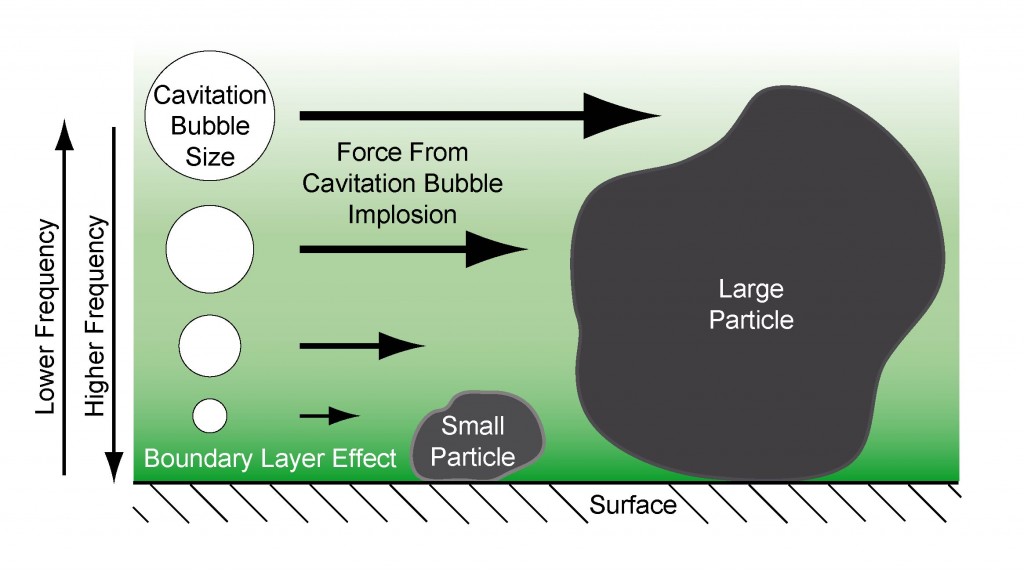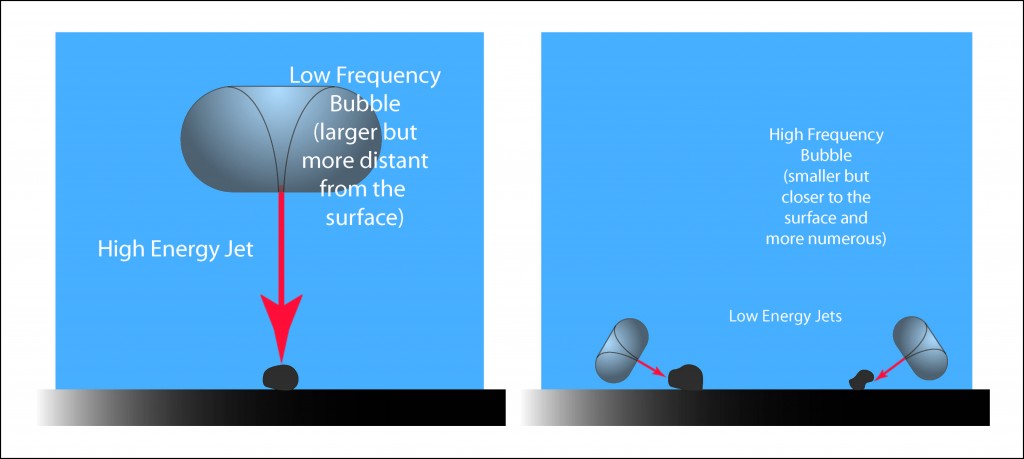A previous blog revealed that ultrasonic frequency has an effect on the removal of soluble contaminants. In general, lower frequency will be more effective in the removal of soluble contaminants. Today’s blog will discuss the effect of frequency on the removal of insoluble contaminants – ie. particles.
As ultrasonic frequency is increased, two things happen. First, the cavitation bubbles and their resulting implosions become more numerous but less energetic. Reference – Ultrasonics – Number and Size of Cavitation Bubbles. Secondly, the thickness of the barrier layer (the zone near a surface where cavitation can not occur due to physical constraints on the liquid) is reduced. Reference – Ultrasonics – Frequency – Barrier Layer. These two effects have a significant impact on the removal of particles from a surface. The following illustration will be helpful in understanding the discussion that follows.

The removal of larger particles usually benefits from the higher implosion intensity of the larger cavitation bubbles produced at lower frequencies, let’s say 25 to 40 kHz. This is, in part, due to the fact that larger particles tend to be more strongly bonded to the substrate and, therefore, require the release of more energy to break the bonds than do smaller particles which are more loosely bonded. But, we also know that these larger, more energetic bubbles can not occur in close proximity to a surface due to the barrier layer effect. Particle removal requires both sufficient energy and a proper angle of attack. Although larger cavitation bubbles may be required to break the bonds holding large particles, they lack the benefit of attack angle required to remove small particles as shown in the following illustration.

In fact, the energy of the implosions of larger cavitation bubbles at an angle that drives the smaller particles closer to the surface may be counter-productive in the removal of smaller particles making them, ultimately, more difficult to remove by any means. This, to my knowledge, has never been proven but seems logical.
In previous blogs about cavitation bubble implosion it was indicated that the cavitation bubble tends to implode directing its energy toward a discontinuity – the liquid/substrate interface, for example. The fact is that as the cavitation bubble size becomes smaller, the “discontinuity” is more likely to be the liquid/particle interface. The energy of the imploding cavitation bubble is not always directed only toward the surface being cleaned.
All of the above makes a strong case for using higher frequency ultrasonics to remove smaller particles. In fact, that is common practice. Particles, however, seldom travel alone and are seldom of any particular size in a given cleaning application. This sets the stage for using multiple frequencies in many critical cleaning applications to achieve effective removal of both small and large particles. Upcoming blogs will explore how this is accomplished in today’s ultrasonic cleaning systems.
– FJF –



 English
English Spanish
Spanish Chinese
Chinese Canada
Canada Mexico
Mexico United Kingdom
United Kingdom



